Strategy Analysis
Chapter 6. Strategy Analysis
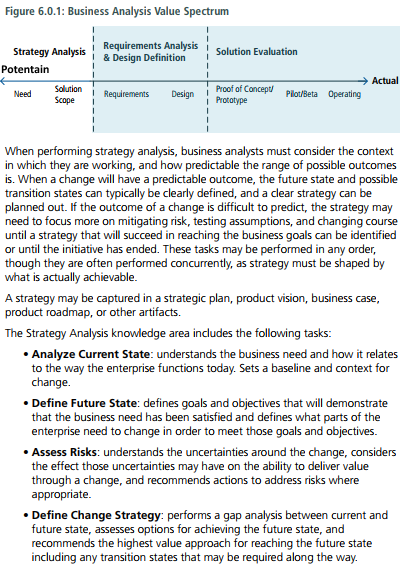

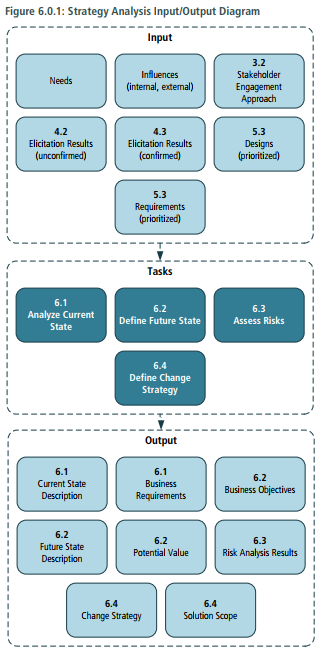
Each Task in the BABOK Guide is presented in the following format:
- Purpose >
- Description >
- Inputs >
- Elements >
- Guidelines / Tools >
- Techniques >
- Stakeholders >
- Outputs >
1. Analyze Current State
- Purpose > The purpose of Analyze Current State is understand the reason why an enterprise needs to change some aspect of how it operates what wold be directly or indirectly affected by the change.
- Description > The starting point of change is an understand of why the change is need. Potentail change is triggerred by problems or opportunities that cannot be addressed without altering the current state. Business analysts work to help stakeholders enable change by exploring and alcutilating the business needs that drive the desire to change. Without clearly understood business needs, it is impossible to develop a coherent strategy, and the resulting change initiative is almost certian to be driven by a mix conflicting stakeholder demands.
- Inputs > Elicitation Results > Needs

- Elements > Business Needs > Organization Struceture and Culture > Capabilities and Processes > Technology and Infrastructure > Policies > Business Architecture > Internal Assets > External Influencers (Industry Structure/ Compertitors/ Customers/ Suppliers/ Political and Regulator Environment/ Technology/ Macroeconomic Factors)
- Guidelines / Tools > Analysis Aproach > Enterprise Limitation/ Organizational Strategy/ Solution Limitation/ Solution Performance Goals/ Solution Performance Measures/ Stakeholder Analysis Results.
- Techniques > Benchmarking and Market Analysis > Business Capability Analysis > Business Model Canvas > Business Cases > Concept Modelling > Data Mining > Document Analysis > Finacial Analysis > Focus Groups > Functional Decomposition > Int erviews > Item Tracking > Lessons Learned > Metrics and Key Performance Indicators (KPIs) > Mind Mapping > Observaton > Organizational Modelling > Process Analysis > Process Analysis > Process Modelling > Risk Analysis and Management > Root Cause Analysis > Scope Modelling > Survey or Questionnaire > SWOT Analysis > Vendor Assessment > Workshops
- Stakeholders > Customer > Domain Subject Matter Expert > End User > Implementation Subject Matter Expert > Operational Support > Project Manager > Regulator > Sponsor > Supplier > Tester
- Outputs > Current State Description : the context of the enterprise's scope, capabilities, resources, performance, culture, dependencies, infrastructure, external influences, and significant relationships between these elements. > Business Requirements: The problem, opportunity, or constraint which is defined based on an understanding of the current state.
2. Define Future State
- Purpose > The purpose of Define Future State is to determine the set of necessary conditions to meet the business need.
- Description > All purposeful change must include a defination of success. Business analysts work to ensure that the future state of the enterprise is well defined, that is achievable with the resource availabe, and that key stakeholders have a shared consensus vision of the outcomes. As with current state analysis, the purpose of future state analysis is not to create a comprehensive description of the outcome at a level of detail that will directly support implementation.
- Inputs > Business Requirements
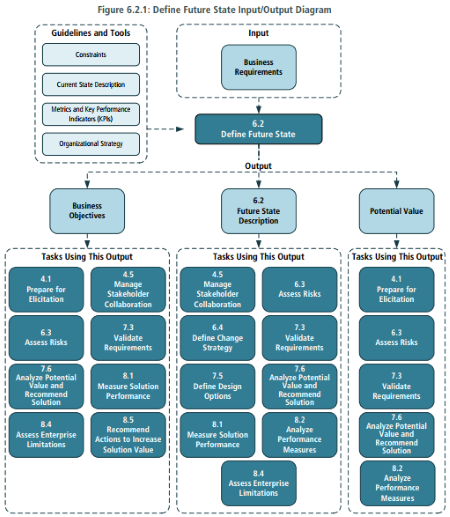
- Elements > Business Goals and Objectives (SMART : Specific/ Measureable/ Achievable/ Relevant/ Time-bounded ) > Scope of Solution Space > Constraints > Organization Structre and Culture > Capabilities and Processes > Technology and Infrastructure) > Policies > Business Architecture > External Assets > Identify Assumptions > Potentail Value
- Guidelines / Tools > Current State Description/ Metric and Key Performance Indicators (KPIs) > Organizational Strategy
- Techniques > Acceptance and Evaluation Criteria > Balanced Scorecard > Benchmarking and Market Analysis > Brainstorming > Business Capability Analysis > Business Cases > Business Model Canvas > Decision Analysis > Decision Modelling > Financial Analysis > Functional Decomposition > Interviews > Lessons Learned > Metrics and Key Performance Indicators (KPIs) > Mind Mapping > Organizational Modelling > Process Modelling > Prototyping > Scope Modelling > Survey or Questionnaire > SWOT Analysis > Vendor Assessment > Workshops
- Stakeholders > Customer > Domain Subject Matter Expert > End User > Implementation Subject Matter Expert > Operational Support > Project Manager > Regulator > Sponsor > Supplier > Tester
- Outputs > Business Objectives: the desire direction that the business wishes to pursue in order to achieve the future state > Future State Description: the future state description includes boundaries of the purposed new, removed, and modified components of the enterprise and the potential value expected from the future state. The descripton might include the desired future capabilities, policies, resources, independencies, infrastructure, external influencers, and relationships between each element. > Potential Value: the value that maybe realized by implementing the proposed future state.
3. Assess Risks
- Purpose > The purpose of Assess Risks is to understand the undersirable consequences of internal and external forces on enterprise during a transittion to, or once in, the future state. And understanding of the potential impact of those forces can be used to make a recommendation about a course of action.
- Description > Assessing risks includes analyzing and managing them. Risks might be related to the current state, a desire future state, a change itself,a change strategy, or any task being performanced by the enterprise.
- Inputs > Business Objectives > Elicitation Results (confirmed) > Influencers > Potential Value > Requirements (prioritized)
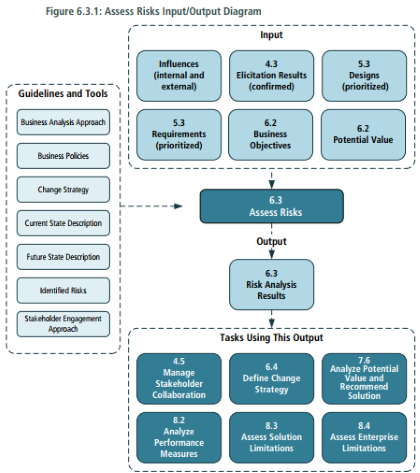
- Elements > Unknows > Constrains, and Dependencies > Negative Impact to Value > Risks Tolenrance > Recommendation
- Guidelines / Tools > Business Analysis Approach > Business Policies > Change Strategy > Current State Description > Future State Description > Identified Risks > Stakeholder Engagement Approach
- Techniques > Brainstorming > Business Cases > Decision Analysis > Document Analysis > Financial Analysis > Interviews > Lessons Learned > Mind Mapping > Risks Analysis and Management > Root Cause Analysis > Survey or Quetionnaire > Workshops
- Stakeholders > Domain Subject Matter Expert > Implementation Subject Matter Expert > Operational Support > Project Manager > Regulator > Sponsor > Supplier > Tester
- Outputs > Risks Analysis Results: an understanding of the risks associated with achieving the future state, and the mitigation strategies which will be used to prevent those risks, reduce the impact of the risk, or reduce the likelihood of the risks occuring.
4. Define Change Strategy
- Purpose > The purpose of Define Change Strategy is to develop and alternative approaches to the change, and then select the recommended approach.
- Description > Developing a change strategy is simpler when the current state and future state are already defined beacause they provide some context for the change.
- Inputs > Current State Description > Future State Description > Risk Analysis Results > Stakeholder Engagement Approach
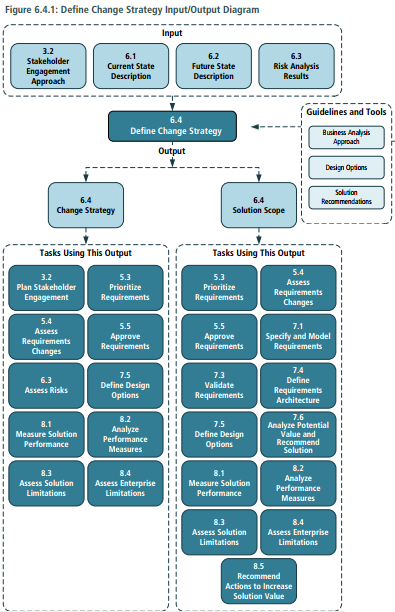
- Elements > Solution Scope > Gap Analysis > Enterprise Readiness Assessment > Change Strategy > Transition States and Release Planning
- Guidelines / Tools > Business Analysis Approach > Design Options > Solution Recommendations
- Techniques > Balanced Scorecard > Benchmarking and Market Analysis > Brainstorming > Business Capabilities Analysis > Business Cases > Business Model Canvas > Decision Analysis > Estimation > Financial Analysis > Focus Groups > Functional Decompositon > Interviews > Lessons Learned > Mind Mapping > Organizational Modelling > Process Modelling > Scope Modelling > SWOT Analysis > Vendor Assessment > Workshops
- Stakeholders > Customer > Domain Matter Expert > End User > Implementation Subject Matter Expert > Operational Support > Project Manager > Regulator > Sponsor > Supplier > Tester
- Outputs > Change Strategy: the approach that the organization will follow to guide change. > Solution Scope: the solution scope that will be achieved through execution of the change strategy.